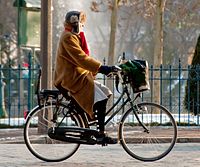
Photo from wikipedia
Abstract Introduction The objective of this study was to analyze the relationships between perceived barriers to active commuting to school (ACS) with physical activity, subjective happiness and quality of life.… Click to show full abstract
Abstract Introduction The objective of this study was to analyze the relationships between perceived barriers to active commuting to school (ACS) with physical activity, subjective happiness and quality of life. Methods A total of 1006 students participated in the study, both males (n = 584) and females (n = 422), aged between 9 and 17 years (M = 12.16, SD = 1.71), belonged to 12 different schools. The questionnaire BATACE used to measure the perceived barriers to ACS. The physical activity was evaluated using the PROCHASKA questions. The subjective happiness scale was used to assess subjective happiness. Finally, the quality of life was measured with the KIDSCREEN-10. Results The structural equation model showed that the perceived barriers predicted the physical activity and the psychosocial variables in the active commuters (p Conclusions The present research showed that perceived barriers to ACS were related to an increase in physical activity, which in turn was associated with an improvement in subjective happiness and quality of life in active commuters. Moreover, it was found a higher physical activity, subjective happiness, and quality of life in young
Journal Title: Journal of transport and health
Year Published: 2021
Link to full text (if available)
Share on Social Media: Sign Up to like & get
recommendations!